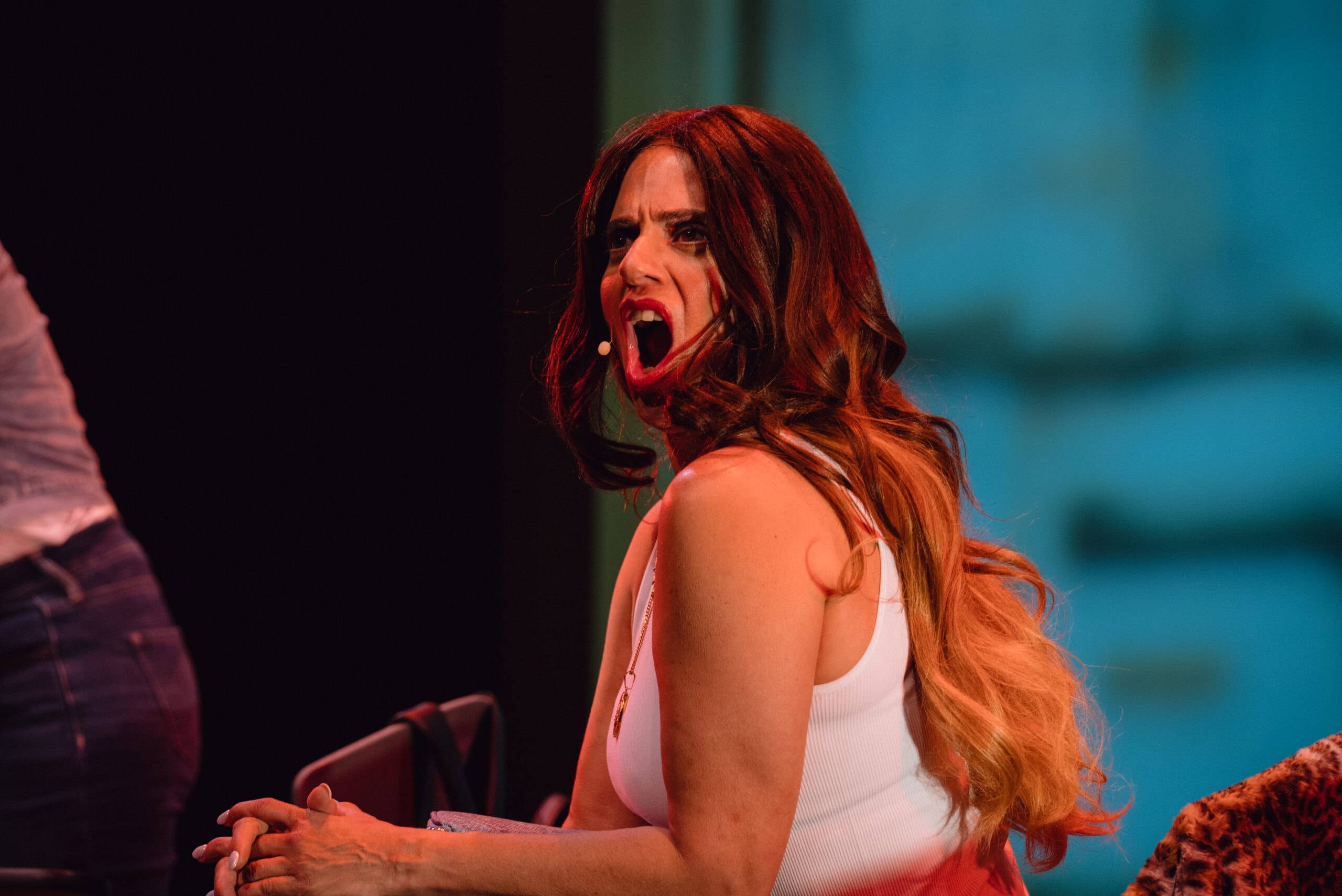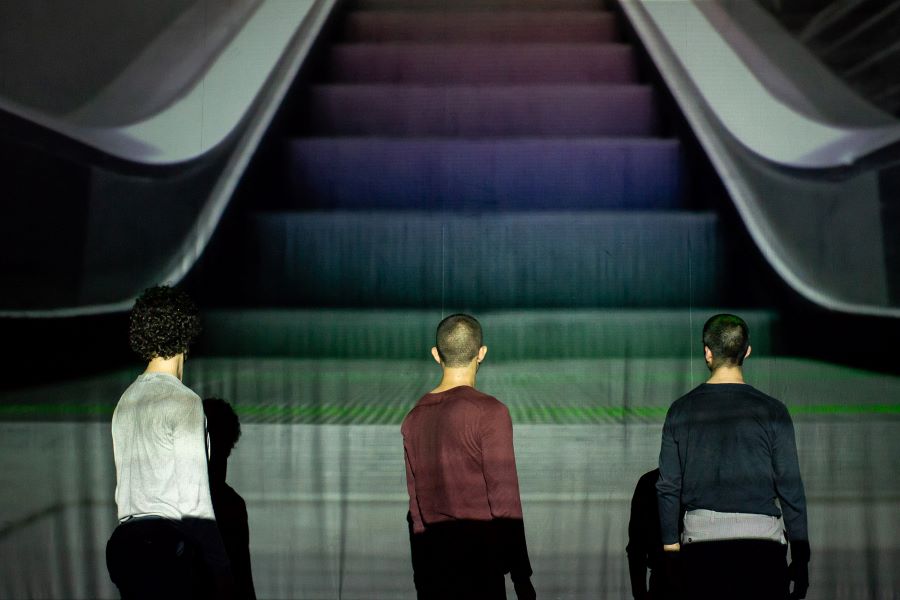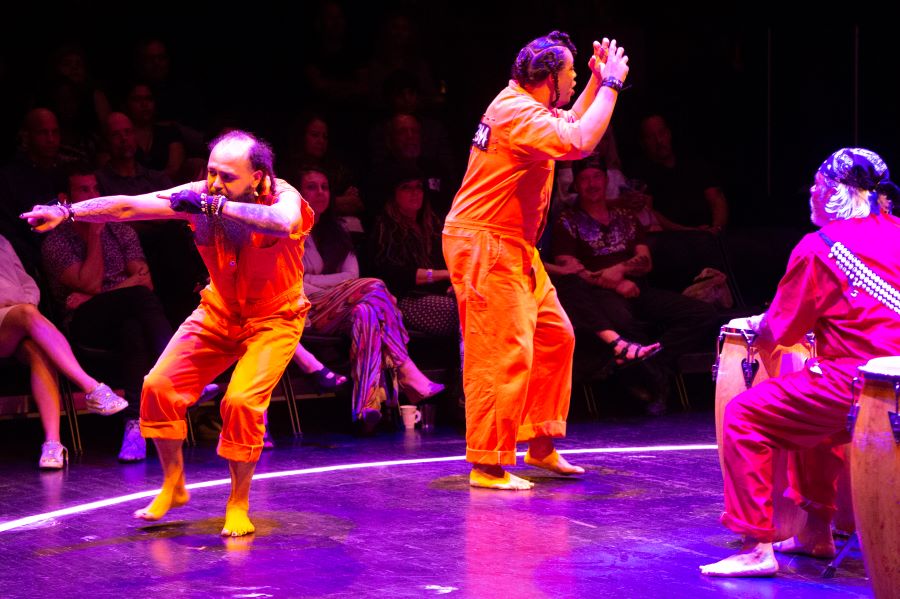Cara Mía Theatre announced this as its biggest and best festival yet. And it delivered: Latinidades, held between Sept. 25 and Oct. 13, sprawled throughout the iconic Latino Cultural Center, a modernist design by Mexican architect Ricardo Legorreta that includes a 300-seat mainstage theatre, an intimate black box of 150-flexible seat capacity, and several galleries. (It is the only cultural facility in the U.S. that houses two resident Latine theatre companies: Cara Mía and Teatro Dallas.) According to Cara Mía’s executive artistic director, David Lozano, the festival and a parallel, three-day symposium ran about $400,000, including staff salaries. Their current annual budget is around $1.4 million (up from $40,000 when Lozano first took over in 2002).
Imagine a free workshop, food, music, and dancing every weekend after the shows. More than a festival, Latinidades was a celebration of community-building.
The festival got off to a brilliant start with Ghostly Labor by La Mezcla, a woman-led Chicana/Latina company that devises stories through their feet. Yes: their feet. The story they told here through dance, singing, and live music was a collaborative effort with a San Francisco Bay Area organization of migrant women domestic workers, La Colectiva de Mujeres (Women’s Collective), and ALAS (Ayudando a Latinos a Soñar, Helping Latinos to Dream), a farm worker outreach program. Both make up the bulk of invisible (i.e., ghost-like) workers that keep the mainstream U.S. nourished and living comfortably.
The project began as a 12-minute film commissioned by Dance Camera West and choreographed by Vanessa Sanchez (creator, director, choreographer, and dancer) titled Ghostly Labor: A Dance Film. Later it was developed into the theatrical dance performance that incorporated visuals from the film.
Choreographed by Sanchez with the company’s 10 women dancers, Ghostly Labor engaged both Afro-American tap dance and the Mexican son jarocho (an offspring of the Spanish flamenco), here mixed with Afro-Caribbean rhythms, bringing together brown and Black cultures. If the rhythm still came from the perfectly synchronized foot work in the tap and son jarocho, the driving energy in the Afro-Caribbean segments came from percussionist pounding: bare-footed on the floor, banging out the essential clave sticks in the air, on the floor, and against wooden wash basins. The energetic percussion sound waves penetrated the entire house, and ran like a tidal wave.
This performance turned out to be an unexpectedly emotional experience for me. Hands down one of the most moving and accomplished performances in the festival, this 90-minute, multi-disciplinary, multimedia work with a large cast of dancers, musicians, and creatives brought to light the struggles of invisible Black and brown workers, and also the joy of collective resistance.
Next up: Bogotá, Colombia’s Teatro Petra presented Yo no estoy loca/I am not insane, a one-woman dark comedy written/directed by Fabio Rubiano, with Marce Valencia performing the role of Cielo, a thin, middle-class woman in her 40s who begins relating her frustration at an ineffectual government health care facility. There were six chairs onstage, and a stand in the rear with water and a glass—that was it. Eventually, Valencia assumed the voices of the invisible characters, though the full weight of the show fell on Cielo, who candidly confided in us the details of her (love) life. Her story included a boyfriend with a tiny penis and a cheating husband, among others.
The piece employed rhetorical questions to hook the audience. Was Cielo crazy because her country’s medical system is in shambles? Did she flip out under the stress of long waits and frustration for health care, or because of her rage upon catching her husband cheating in their country home? She rejected the epithet each time, and by the end of the show, so did we.
The narrative structure had unusual turns: She began speaking in the first person, but later informed us that she would switch to the third person, so as not to sound too sordid (in her husband’s infidelity scene, for instance). At other times she interrupted the narrative to create an ellipsis, telling us that she would get back to this segment later, but first she would tell us about…What I found effective is that at each turn, she would announce the next technique, explaining why this was a better way to tell the story. The elliptical breaks switched not only among characters, but from the first person to an impersonal voice, and from present to past perfect tense. This definitely held our attention, as Yo no estoy loca effectively underscored the insanity of a social system on the verge of breakdown.

Las Jevas is slang for chicks (i.e., girls, women) in Puerto Rican popular culture. Jevas are feisty and generally in-your-face. Teatro Breve’s play of that name offered an audacious look at Puerto Rican culture on both sides of the pond (within and outside the Island). Performed all in Spanish, without subtitles, the piece had such a fast pace that it would have made reading along impossible in any case.
Devised by company members Lucienne Hernández, Lourdes Quiñones, Melissa Rodríguez, Cristina Soler, and Isel Rodríguez on video, and directed by Jessica Rodríguez, the show began with a stand-up piece by performer Melissa Rogríguez, a plus-size woman who makes no qualms about her body. She made us laugh with a diatribe about getting lost on the way to their hotel in Dallas, and later went on about almost sinking a canoe on an excursion. The following short pieces ranged from a hilarious look at two women trying to get their daughters into a fancy New York performing arts school, to “The Guanine, Queen of the Spoken Word,” a poignant poem about why Puerto Ricans leave the island when es la misma mierda (it’s the same shit) wherever they go. The final coup de grace came in the segment parodying a university course on the political allegories in the songs of Benito Antonio Martínez Ocasio, a.k.a. Bad Bunny, the pop star. The discussion among the professor, a feminist student radical, a Christian conservative, and a Bad Bunny fan brought the house down.
Las Jevas was made by and for the Puerto Rican community, but Teatro Breve’s comedic art and the refinement of their craft can be appreciated by Spanish-speaking audiences from anywhere. The fact that Spanish only was used is in itself a statement of resistance to the Island’s colonization by the United States since 1898.
Next were two pieces from Mexico City’s ASYC/El Teatro de Movimiento. El primer abrazo/The first embrace was a one-man dance/poetic piece created and performed by Luis Villanueva, a company member, originally developed with Chilean artist Daniel Arce during an artistic residency in Amatlán de Quetzalcóatl, in Morelos, Mexico. In Amatlán, the amate trees form a symbiotic relationship with the rocky terrain; in the interlaced relationship between the tree roots and the rocks, one may wonder who is sustaining who.
In the dance piece Villanueva—bare-footed, wearing neutral-colored street clothing—moved around four sets of poles about five feet high, tied by yute (hemp rope) to a rock, which eventually stood as independent, triangular structures on the stage. He danced to a poetic voice that spoke of the personal need of holding on, of belonging. At one point, the bass and the harmonica gave the sensation of calling us home, wherever that may be.

Meanwhile Resonancias…algo que no se ha agotado (Resonances… something that has not been exhausted), a longer dance/poetic piece by ASYC: El Teatro de Movimiento, featured three male dancers (Luis Villanueva, Ángel Cerón, and Tlatui Maza), also bare-footed and dressed in neutral-colored street clothes, took us on a journey of life in a huge urban area like Mexico City (in 2024, the second most populated city behind Tokyo). Resonancias was made with the premise that ¨everything in life has a rhythm.¨ We heard the noise of the city as part of the soundscape.
Choreographed by Alicia Sánchez, the piece comprised discrete segments. From a jaded subway commuter’s reluctance to cede a seat to an ill woman to an allegorical segment based on images of the dramatic collapse of Tacoma Narrows Bridge in Washington state in 1940, the show portrayed human beings crossing borders to work and function. The male dancers demonstrated physical strength and fluidity in the complex array of continuous movement.
The Combat Hippies, a male group from Puerto Rico known for their bold explorations of trauma, resilience, and identity, delivered an emotionally stirring performance in AMAL. Teo Castellanos, the company’s artistic director, worked with writer/performers Anthony Torres, Hipólito Arriaga, and Angel R. Rodriguez Sr. Drawing on their experiences as veterans of war and descendants of diverse Latine communities, the group wove together a narrative both deeply personal and universally resonant. Through a blend of spoken word, music, and movement, AMAL (“hope” in Arabic) became a powerful meditation on healing, displacement, and the complexities of identity for those caught between the scars of war and the struggles of migration.
Imbued with the weight of lived experience, the troupe offered a rare and intimate look at the psychological toll of combat, especially as men of color navigating both military service and the sociopolitical realities of Latinx communities. What makes AMAL truly impactful was its seamless integration of cultural references, from bomba y plena rhythms to Afro-Latine spirituality, and even the use of Arabic motifs. This reflected the global intersections of the group’s narrative, which heightened the sense of ritual and catharsis, turning the performance into a communal experience of grief, hope, and reconciliation.

Closing the festival was Yemayá Flamenco, billed as “a concept dance piece” of ritual reverence, which four distinct companies devised together in just two weeks. These included the New Orleans Original Buckshop, with director/performer Michelle Gibson and Mama Sula contributing the Afro-Cuban Santería dance and ritual forms of dance; the Flame Foundation, Dallas’s flamenco troupe, with bailaor/choreographer Antonio Arrebola and bailaora/co-producer Delilah Buitrón Arreola; Mulato Teatro from Ticumán, Morelos, Mexico, with dramaturg Jaime Chabaud and production dramaturg Marisol Castillo; and Cara Mía Theatre’s David Lozano (producer) and Gabriela Leodiou (associate producer).
Billed as a work in progress, Yemayá Flamenco turned the stage into a vessel for an extraordinarily respectful meeting of cultures, history, and spiritual expression. It brought together the percussive rhythms of Spanish flamenco and the powerful, ritualistic movements of Afro-Caribbean danced faiths, particularly the worship of Yemayá, the Orisha of the sea and the Mother of All in the Yoruba religion.
The integration of the flamenco guitar and cajón with the batá and other Afro-Caribbean percussion instruments created a soundscape that both honored the flamenco cante jondo (deep song) and mirrored the call-and-response traditions of Afro-Caribbean music. The result was a rhythmic conversation between cultures that went beyond oppositional binaries of colonizer and colonized.
Over the weeks of Latinidades, Ghostly Labor, Resonancias, Amal, and Yemayá Flamenco brought to Dallas a transcendent tribute to the power of dance as a medium for theatrical and cultural communion, and challenged the boundaries that divide, while paying deep respect to their own traditions. And like the theatrical pieces Loca… and Jevas, which employed humor to similar ends, these performances imprinted memories that will last long after the shows—and the festival—end.
Teresa Marrero is professor of Latine and Latin American theatre and cultures at the University of North Texas, Department of Spanish. She is co-editor of several anthologies, including Out of the Fringe (TCG 2000), Encuentro: Latinx Performance for the New American Theatre (Northwestern U. P. 2019), and Seeking Common Ground (Methuen 2022).


